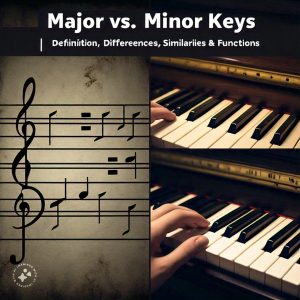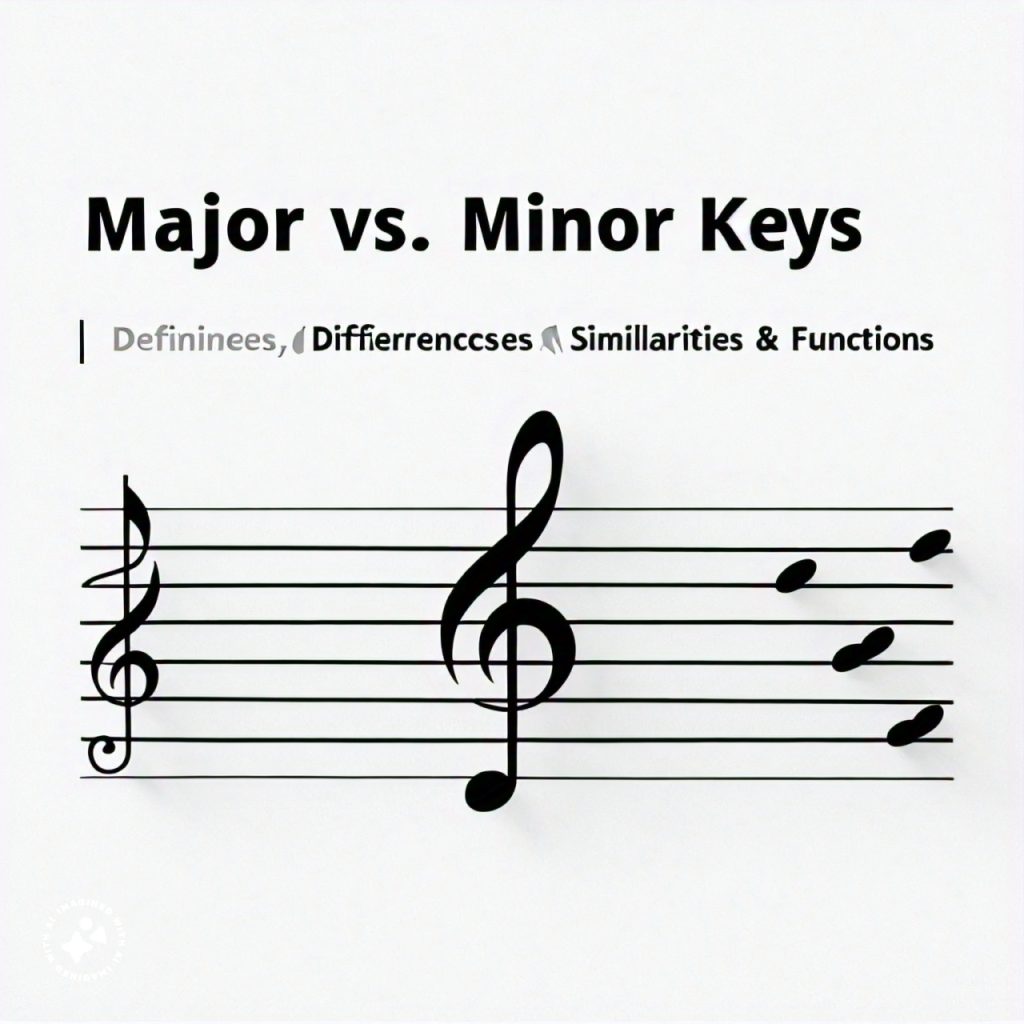Hello, are you a Songwriter or a singer and you want to know the difference between Major and Minor Keys? Well, you are on the right page because here in this post, we are going to talk about ”Major vs. Minor Keys | Definition, Differences, Similarities & Functions.
As a singer-songwriter with years of belting ballads and strumming happy tunes, I’ve always been fascinated by the invisible force that breathes life into music: keys. These aren’t the shiny things you press on a piano (though those are important, too!), but rather the tonal landscapes that shape the emotional tapestry of a song. Whether it’s the soaring joy of a major-key anthem or the introspective whispers of a minor-key ballad, keys hold the power to move our hearts and stir our souls.
But what exactly are major and minor keys, and how do they differ? Fear not, music enthusiasts and curious minds! This comprehensive guide will be your key (pun intended) to unlocking the mysteries of these fundamental musical concepts. We’ll delve into their definitions, explore their unique characteristics, and discover how they work together to create the rich tapestry of music we all love.
What are the Major Keys?
-
“Here Comes the Sun” by The Beatles (A major)
-
“I Will Always Love You” by Whitney Houston (C major)
-
“Best Day of My Life” by American Authors (C major)
NOTE: Major keys are constructed using a specific pattern of whole and half steps called a major scale. This scale consists of seven notes, with a particular arrangement of intervals between them. The interval pattern for a major scale is:
- Whole step
- Whole step
- Half step
- Whole step
- Whole step
- Whole step
- Half step
Let’s take the key of C major, for example. Starting on note C, we follow the major scale pattern to reach the remaining notes: C, D, E, F, G, A, B, and back to C.
Characteristics of Major Keys:
The specific arrangement of intervals on a major scale creates a bright and cheerful sound. The major third interval (the distance between the first and third notes) is particularly crucial in shaping this characteristic sound. It adds a sense of resolution and stability that contributes to the overall happy vibe.

So next time you hear a song that makes you want to tap your feet and sing along, pay attention! It’s likely basking in the sunshine of a major key.
Examples of Genres that Heavily Utilize Major Keys:
- Pop
- Rock
- Folk
- Country
- Musical Theatre
What are Minor Keys?
-
“Stairway to Heaven” by Led Zeppelin (A minor)
-
“Hallelujah” by Leonard Cohen (C minor)
-
“Someone Like You” by Adele (A minor)
NOTE: Similar to major keys, minor keys are built upon scales. However, the minor scale has a different interval pattern compared to the major scale. Here, the crucial difference lies in the relationship between the first and third notes. In a minor scale, the third note is flattened (lowered by a half step) compared to a major scale. This adjustment creates a darker and more dissonant sound, contributing to the emotional depth associated with minor keys.
There are actually three main types of minor scales used in music:
- Natural minor scale: This is the most common type of minor scale and the one we’ll focus on primarily.
- Harmonic minor scale: This variation is used to create more leading tones within a minor key, adding a touch of drama.
- Melodic minor scale: This scale uses different intervals for ascending and descending melodies, offering more melodic flexibility.
Characteristics of Minor Keys:
The flattened third note in a minor scale creates a more tense and unresolved sound than a major key. Depending on the context, this dissonance can evoke feelings of sadness, longing, or even mystery. Minor keys offer a rich palette for exploring deeper emotions in music.
Examples of Genres that Heavily Utilize Minor Keys:
- Classical
- Jazz
- Blues
- Rock (especially subgenres like heavy metal and emo)
Differences between Major and Minor Keys
-
Emotional Connotation: Major keys tend to evoke happiness and positivity, while minor keys are often associated with sadness and introspection.
-
Scale Patterns: Major and minor scales have distinct whole and half-step formulas, resulting in different sounds and moods.
-
Chord Progressions: Major keys typically use major chords (e.g., C major), while minor keys use minor chords (e.g., C minor).
- Usage in Music Genres: Major keys are commonly found in upbeat and celebratory music genres, including pop, rock, and folk music. Minor keys are prevalent in genres that explore deeper emotions and themes, such as blues, jazz, and classical music.
Similarities between Major and Minor Keys
-
Shared Notes: Major and minor keys often share common notes, making it possible to modulate between them smoothly.
-
Relative Keys: Major and minor keys have relative keys, which are the major and minor keys that share the same key signature. For example, C major and A minor are relative keys.
-
Emotional Depth: Both major and minor keys can convey a range of emotions, from joy to sadness and everything in between.
-
Expressive Potential: Both major and minor keys provide composers and performers with a wide range of expressive possibilities, from joyful exuberance to poignant introspection, enhancing the emotional impact of music.
-
Modulation Possibilities: Major and minor keys offer opportunities for modulation, allowing composers to transition between keys and explore different tonalities within a musical piece.
While major and minor keys offer distinct sonic personalities, they’re not entirely separate universes. There are fascinating connections between them that shed light on how music works.
Functions of Major and Minor Keys in Music

-
Setting the Mood: Major and minor keys can instantly establish the mood or atmosphere of a song.
-
Creating Contrast: Switching between major and minor keys can add depth and contrast to a piece, keeping listeners engaged.
-
Conveying Emotion: Major and minor keys can be used to convey different emotions and moods, making music a powerful storytelling tool.
How Major and Minor Keys Shape a Song
Now that we’ve explored the characteristics of major and minor keys, let’s delve into how they function within a song. Keys aren’t just static backdrops; they actively shape a piece of music’s emotional journey.
For Musicians: The Key to Unlocking Creativity
For musicians, understanding keys is like having a secret decoder ring for the language of music. It unlocks a treasure trove of creative possibilities:
- Composition: Grasping keys allows you to craft songs with intention. You can choose keys that evoke specific emotions and experiment with modulations to add depth and complexity to your compositions.
- Playing by Ear: Recognizing key signatures becomes easier, allowing you to learn songs by ear more effectively.
- Improvisation: Understanding keys empowers you to improvise solos and riffs with greater confidence, knowing the notes that fit within the tonal framework.


